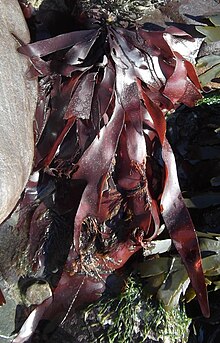Dulse
| Palmaria palmata | |
|---|---|
 |
|
| Scientific classification | |
| Domain: | Eukaryota |
| (unranked): | Archaeplastida |
| Division: | Rhodophyta |
| Class: | Florideophyceae |
| Order: | Palmariales |
| Family: | Palmariaceae |
| Genus: | Palmaria |
| Species: | P. palmata |
| Binomial name | |
|
Palmaria palmata (L.) F.Weber & D.Mohr |
|
| Synonyms | |
|
|
Palmaria palmata, also called dulse, dillisk or dilsk (from Irish/Scottish Gaelic duileasc/duileasg), red dulse, sea lettuce flakes, or creathnach, is a red alga (Rhodophyta) previously referred to as Rhodymenia palmata. It grows on the northern coasts of the Atlantic and Pacific Oceans. It is a well-known snack food. In Iceland, where it is known as söl, it has been an important source of dietary fiber throughout the centuries.
The earliest record of this species is of St Columba's monks harvesting it 1,400 years ago.
The erect frond of dulse grows attached by its discoid holdfast and a short inconspicuous stipe epiphytically on to the stipe of Laminaria or to rocks. The fronds are variable in colour from deep rose to reddish purple and are rather leathery in texture. The flat foliose blade gradually expands and divides into broad segments ranging in size to 50 centimetres (20 in) long and 3–8 cm (1.2–3.1 in) in width which can bear flat, wedge-shaped proliferations from the edge.
The reference to Rhodymenia palmata var. mollis in Abbott and Hollenberg (1976), is now considered to refer to a different species: Palmaria mollis (Setchel et Gardner) van der Meer et Bird.
Dulse is similar to another seaweed, Dilsea carnosa, but Dilsea is more leathery with blades up to 30 cm (12 in) long and 20 cm (7.9 in) wide. Unlike P. palmata, it is not branched and does not have proliferations or branches from the edge of the frond, although the older blades may split.
The full life history was not fully explained until 1980.Tetraspores occur in scattered sori (spores) on the mature blade, which is diploid. Spermatial sori occur scattered over most of the frond of the haploid (single cell) male plant. The female gametophyte is very small stunted or encrusted, the carpogonia, the female nucleus, apparently occurring as single cells in the young plants. The male plants are blade-like and produce spermatia which fertilize the carpogonia of the female crust. After fertilization, the diploid plant overgrows the female plant and develops into the tetrasporangial diploid phase attached to the female gametophyte. The adult tetrasporophyte produces tetraspores meiotically in fours.
...
Wikipedia
